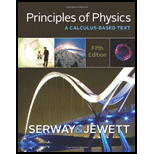
(a)
To show: The overall efficiency of the two engine is
(a)
Answer to Problem 8P
The overall efficiency of the two engine is
Explanation of Solution
Given info: The efficiency of the two engine is
Write the expression of the efficiency of the engine
Here,
Write the expression of the efficiency of the engine
Here,
The exhaust
Here,
Substitute
Write the expression of the efficiency of the two engine device.
Substitute
Substitute
Conclusion:
Therefore, the overall efficiency of the two engine is
(b)
The efficiency of the combination engine.
(b)
Answer to Problem 8P
The efficiency of the combination engine is
Explanation of Solution
Given info: The efficiency of the two engine is
The overall efficiency of the two engine is,
Write the expression of the Carnot efficiency of the engine
Write the expression of the Carnot efficiency of the engine
Substitute
Conclusion:
Therefore, the efficiency of the combination engine is
(c)
Whether the efficiency is improved by using two engine instead of one.
(c)
Answer to Problem 8P
The efficiency is remains same even after combining the two engine.
Explanation of Solution
Given info: The efficiency of the two engine is
The Carnot engine has the maximum efficiency and no engine can have the efficiency more than the Carnot engine’s efficiency.
If the two Carnot engine is combined together than the efficiency is remain same because the combined engine is also a Carnot engine. So there is no requirement to use two engines simultaneously instead of one engine to improve the net efficiency. The work output increases but on the other hand the heat supplied also increase.
Conclusion:
Therefore, the efficiency is remains same even after combining the two engine.
(d)
The value of the intermediate temperature
(d)
Answer to Problem 8P
The value of the intermediate temperature
Explanation of Solution
Given info: The efficiency of the two engine is
The work done by both the engine is same.
Write the expression of the efficiency of the two engine device.
Substitute
Substitute
Substitute
Conclusion:
Therefore, the value of the intermediate temperature
(e)
The value of the intermediate temperature
(e)
Answer to Problem 8P
The value of the intermediate temperature
Explanation of Solution
Given info: The efficiency of the two engine is
The efficiency of both the engine is same.
Substitute
Conclusion:
Therefore, the value of the intermediate temperature
Want to see more full solutions like this?
Chapter 18 Solutions
Bundle: Principles of Physics: A Calculus-Based Text, 5th + WebAssign Printed Access Card for Serway/Jewett's Principles of Physics: A Calculus-Based Text, 5th Edition, Multi-Term
- Identical rays of light enter three transparent blocks composed of different materials. Light slows down upon entering the blocks.arrow_forwardFor single-slit diffraction, calculate the first three values of (the total phase difference between rays from each edge of the slit) that produce subsidiary maxima by a) using the phasor model, b) setting dr = 0, where I is given by, I = Io (sin (10) ². 2arrow_forwardA capacitor with a capacitance of C = 5.95×10−5 F is charged by connecting it to a 12.5 −V battery. The capacitor is then disconnected from the battery and connected across an inductor with an inductance of L = 1.55 H . (D)What is the charge on the capacitor 0.0235 s after the connection to the inductor is made? Interpret the sign of your answer. (e) At the time given in part (d), what is the current in the inductor? Interpret the sign of your answer. (f) Atthe time given in part (d), how much electrical energy is stored in the capacitor and how much is stored in the inductor?arrow_forward

 Principles of Physics: A Calculus-Based TextPhysicsISBN:9781133104261Author:Raymond A. Serway, John W. JewettPublisher:Cengage Learning
Principles of Physics: A Calculus-Based TextPhysicsISBN:9781133104261Author:Raymond A. Serway, John W. JewettPublisher:Cengage Learning College PhysicsPhysicsISBN:9781938168000Author:Paul Peter Urone, Roger HinrichsPublisher:OpenStax College
College PhysicsPhysicsISBN:9781938168000Author:Paul Peter Urone, Roger HinrichsPublisher:OpenStax College Physics for Scientists and Engineers: Foundations...PhysicsISBN:9781133939146Author:Katz, Debora M.Publisher:Cengage Learning
Physics for Scientists and Engineers: Foundations...PhysicsISBN:9781133939146Author:Katz, Debora M.Publisher:Cengage Learning Physics for Scientists and Engineers, Technology ...PhysicsISBN:9781305116399Author:Raymond A. Serway, John W. JewettPublisher:Cengage Learning
Physics for Scientists and Engineers, Technology ...PhysicsISBN:9781305116399Author:Raymond A. Serway, John W. JewettPublisher:Cengage Learning Physics for Scientists and Engineers with Modern ...PhysicsISBN:9781337553292Author:Raymond A. Serway, John W. JewettPublisher:Cengage Learning
Physics for Scientists and Engineers with Modern ...PhysicsISBN:9781337553292Author:Raymond A. Serway, John W. JewettPublisher:Cengage Learning





